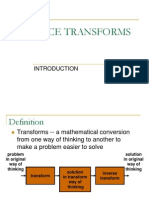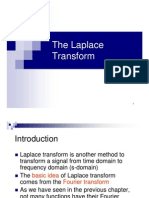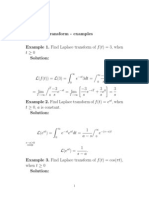Laplace Transforms - GATE Study Material in PDF
Laplace Transforms - GATE Study Material in PDF
Uploaded by
Praveen AgrawalCopyright:
Available Formats
Laplace Transforms - GATE Study Material in PDF
Laplace Transforms - GATE Study Material in PDF
Uploaded by
Praveen AgrawalCopyright
Available Formats
Share this document
Did you find this document useful?
Is this content inappropriate?
Copyright:
Available Formats
Laplace Transforms - GATE Study Material in PDF
Laplace Transforms - GATE Study Material in PDF
Uploaded by
Praveen AgrawalCopyright:
Available Formats
Laplace Transforms - GATE Study Material in
PDF
As a student of any stream of Engineering like GATE EC, GATE EE, GATE CS, GATE CE, GATE
ME, you will come across one very important concept in Engineering Mathematics Laplace
Transforms. The application of Laplace Transforms is wide and is used in a variety of
subjects like Control Systems, Network Theory / Electrical Network and Signals & Systems.
If you are preparing for GATE 2017, you should use these free GATE Study Notes, to help
you ace the exam. You can also download this GATE Study Material in PDF for revision and
reference later. Now let us take a look at the different Laplace Transforms formulas and
concepts.
Laplace Transform Concepts
i. The Laplace transform converts integral and differential equations into algebraic
equations.
ii. It also converts time domain signal into frequency domain signal.
iii. The Laplace transform of a signal f(t) is denoted by L{f(t)} = F(s).
where F(s) = f(t)est dt (for Bilateral)
F(s) = 0 f(t)est dt (For Unilateral)
iv. Inverse Laplace transform converts a frequency domain signal into time domain signal.
1
+j
i. e f(t) = 2j j f(t)est ds
Where is large enough that F(s) is defined for Re{s} .
Laplace Transforms Formulas
The formulae given below are very useful to solve the many Laplace Transform based
problems
1|Page
(1) L{1} =
1
s
(2) L{t n } =
=
(n+1)
sn+1
n!
If n is integer
sn+1
If n is a rational number ( )
q
(3) L{eat } =
1
sa
(4) L{eat } =
1
s+a
(5) L{sin at} =
(6) L{cos at} =
a
s2 +a2
s
s2 +a2
a
(7) L{sinh at} =
s2 a2
s
(8) L{cosh at} =
s2 a2
b
(9) L{eat sin bt} = (sa)2
+b2
sa
(10) L{eat cos bt} = (sa)2
1
+b2
(11) L{f(at)} = |a| F ( )
a
(12) L{(t)} = 1
(13) L {
f(t)
t
t
} = s F(s). ds
(14) L {0 f(t)dt} =
F(s)
s
(15) L{t n f(t)} = (1)n .
dn
dsn
F(s)
(16) If f(t + T) = f(t) then L{f(t)} =
2|Page
1
1esT
0 f(t)est dt
(17) L{f (t)} = sF(s) f(0)
(18) L{f (t)} = s 2 F(s) sf(0) f (0)
(19) L{f n (t)} = s n F(s) s n1 f(0) s n2 f (0) . f n1 (0)
t
(20) L{f(t) g(t)} = F(s). G(s) where f(t) g(t) = 0 f()g(t )d
(21) L{t} =
1
s2
Example Problems of Laplace Transforms
Example 1:
Find the value of L{t cos bt}
Solution:
s
We know that L{cos bt} = s2 +b2
L{t. f(t)} =
d
ds
[F(s)]
d
L{t cos bt} = ds [s2 +b2 ]
= [
(s2 +b2 )s(2s)
(s2 +b2 )
s2 b2
L{t cos bt} = (s2 +b2 )2
Example 2:
Find the Laplace transform of f(t) =1; 0 t < 2
= t-2; 2t
Solution:
F(s) = L{f(t)} = f(t)est dt
2
= 0 1. est dt + 2 (t 2)est . dt
3|Page
est
est
= [ s ] + [(t 2) ( s ) (1) (
0
est
s2
)]
= s [e2s 1] + [(0 0) (0 s2 e2s )]
1
= s e2s + s + s2 e2s = s +
(1s) 2s
e
s2
Example 3:
s+1
Find the inverse Laplace transform of F(s) = s2 +4
Solution:
s+1
Given, F(s) = s2 +4
s
= s2 +4 + s2 +4
s
F(s) = s2 +22 + 2 . s2 +22
Apply inverse Laplace transform then we get
1
f(t) = cos 2t + 2 sin 2t
Example 4:
s+3
Find the inverse Laplace transform of the function F(s) = log (s+4)
Solution:
s+3
Given, F(s) = log (s+4)
F(s) = log(s + 3) log(s + 4)
d
ds
F(s) = s+3 s+4
Apply inverse Laplace transform then we get
t. f(t) = e3t e4t
4|Page
f(t) =
e4t e3t
t
Initial Value Theorem
If L{f(t)} = F(s) then It x(t) = It s. X(s)
t0
Note:
Initial value theorem is applicable only if the function is strictly proper function i.e. Number
of poles of X(s) is greater than the number of zeros of X(s).
Final Value Theorem
If L{f(t)} = F(s) then It x(t) = It s. X(s)
t
s0
Note:
i. Final value theorem is applicable only when the system is stable i.e. all the poles of X(s)
should be lie on the Left Half of s-plane.
ii. If there are pairs of complex conjugate poles on the imaginary axis x(t) will contain
sinusoidal components and final value is not defined.
Example Problems of Inverse Value Theorem & Final
Value Theorem
Example 1:
Given that y 5y + 6y = 0, y(0) = 2 and y (0) = 2. Then find the value of y(t) at t = 1
Solution:
Given, y 5y + 6y = 0
Apply Laplace transform on both sides then, we get
[s 2 Y(s) sy(0) y (0)] 5[sY(s) y(0)] + 6Y(s) = 0
(s2 5s + 6)Y(s) 2s 2 + 5(2) = 0
5|Page
(2s8)
Y(s) = s2 5s+6
(2s8)
Y(s) = (s3)(s2)
(68)
2(2)8
Y(s) = (s3)(32) + (s2)(23)
2
Y(s) = s3 + s2
y(t) = 4e2t 2e3t
y(1) = 4e2 2e3 = 10.615
Liked this article on Laplace Transforms? Let us know in the comments! Here are more
articles that you may like
Practice on GATE 2017 Virtual Calculator
Recommended Books for Engineering Mathematics in GATE
General Aptitude Syllabus with Samples for GATE 2017
Basic Network Theory Concepts
Types of Matrices
Rank of a Matrix & Its Properties
6|Page
You might also like
- Big 10 AP Exam Review Units 1-8Document3 pagesBig 10 AP Exam Review Units 1-8yooh9814No ratings yet
- Domingos, Geometrical Properties of Vectors and Covectors9812700447Document82 pagesDomingos, Geometrical Properties of Vectors and Covectors9812700447Barbara Yaeggy100% (1)
- Laplace Transform NotesDocument23 pagesLaplace Transform NotesmorbidlarueNo ratings yet
- Chapter 5: Laplace Transform and Its ApplicationsDocument23 pagesChapter 5: Laplace Transform and Its ApplicationsEECS7No ratings yet
- Laplace TransformsDocument22 pagesLaplace TransformsAustin JamesNo ratings yet
- Notes LT1Document21 pagesNotes LT1deathesNo ratings yet
- Indian Institute of Technology Roorkee Department of Electronics & Computer Engineering Signals & Systems (ECN 203) Tutorial Sheet No: 5Document2 pagesIndian Institute of Technology Roorkee Department of Electronics & Computer Engineering Signals & Systems (ECN 203) Tutorial Sheet No: 5Black ReaperNo ratings yet
- Ch7 Laplace TransformDocument15 pagesCh7 Laplace TransformumerNo ratings yet
- LaplaceDocument87 pagesLaplaceMoonchild HanaNo ratings yet
- Step Functions and Laplace Transforms of Piecewise Continuous FunctionsDocument20 pagesStep Functions and Laplace Transforms of Piecewise Continuous FunctionsLemuel C. FernandezNo ratings yet
- Unit IDocument15 pagesUnit IDominic SavioNo ratings yet
- Tranformada LaplaceDocument52 pagesTranformada LaplaceLuis JimenezNo ratings yet
- 3a LaplaceDocument28 pages3a LaplaceAinur Sya IrahNo ratings yet
- Laplace TransformDocument10 pagesLaplace TransformNor Hayati SamsudinNo ratings yet
- 1st Shifting Theorem LAPLACE TRANSFORMSDocument42 pages1st Shifting Theorem LAPLACE TRANSFORMSPlaiboiNo ratings yet
- Unit 5 - FormulasDocument3 pagesUnit 5 - FormulasAdhi ThyanNo ratings yet
- Engineering Mathematics Questions and AnswersDocument9 pagesEngineering Mathematics Questions and AnswersZaky Muzaffar100% (1)
- ED S.jorgechavez2.Tarea1 Dep2Document4 pagesED S.jorgechavez2.Tarea1 Dep2Frank CorleoneNo ratings yet
- Laplace TransformDocument10 pagesLaplace Transformvicbuen76No ratings yet
- LaplaceDocument133 pagesLaplaceRen MatewNo ratings yet
- 7.1 Definition of The Laplace TransformDocument4 pages7.1 Definition of The Laplace Transformtingliang0831No ratings yet
- Maths 3Document114 pagesMaths 3Shivesh SohawanNo ratings yet
- PDH - e 139Document26 pagesPDH - e 139HassenLNo ratings yet
- Laplace BookDocument51 pagesLaplace BookAjankya SinghaniaNo ratings yet
- Laplace Transforms1Document110 pagesLaplace Transforms1nileshsawNo ratings yet
- Odes Via Laplace Transforms Part 2Document5 pagesOdes Via Laplace Transforms Part 2uploadingpersonNo ratings yet
- Laplace TransformDocument6 pagesLaplace TransformAlwyn KalapuracanNo ratings yet
- Class 3 Mathematical ModelingDocument24 pagesClass 3 Mathematical ModelingAcharya Mascara PlaudoNo ratings yet
- 011 13EG2001 Lecture Notes - Second Shifting TheoremDocument10 pages011 13EG2001 Lecture Notes - Second Shifting TheoremQy LeeNo ratings yet
- Laplace QuestionsDocument49 pagesLaplace QuestionsAmit Thakur100% (1)
- Department of Mathematics & Statistics: at λ t 2 3tDocument1 pageDepartment of Mathematics & Statistics: at λ t 2 3tHardikParwanaNo ratings yet
- Modeling: ∞ −st 1 s 1 s n n! s −at 1 s+a ω s +ω s s +ωDocument4 pagesModeling: ∞ −st 1 s 1 s n n! s −at 1 s+a ω s +ω s s +ωjameelahmadNo ratings yet
- Lecture Notes On Laplace and Z-Transforms: Ali Sinan Sert OzDocument34 pagesLecture Notes On Laplace and Z-Transforms: Ali Sinan Sert OzMarcelo LimaNo ratings yet
- Questions On LaplaceDocument4 pagesQuestions On LaplaceApam BenjaminNo ratings yet
- Laplace ExDocument3 pagesLaplace ExMostafaAlyNo ratings yet
- Assignment 2 SolutionDocument5 pagesAssignment 2 Solutionkaveendra.rcitNo ratings yet
- Mathematical Madeling and Block DiagramaaDocument93 pagesMathematical Madeling and Block Diagramaaabdul.azeezNo ratings yet
- Web Work EcuacionesDocument7 pagesWeb Work EcuacionesAlexMelgarNo ratings yet
- EEE202 Lec13Document17 pagesEEE202 Lec13Osama HassanNo ratings yet
- 03 - The Laplace TransformDocument54 pages03 - The Laplace TransformHandi RizkinugrahaNo ratings yet
- Example SolutionsDocument54 pagesExample Solutionsanup312No ratings yet
- HW1 SolutionsDocument3 pagesHW1 SolutionsMuhammad AbubakerNo ratings yet
- Inverse Laplace TransformsDocument5 pagesInverse Laplace TransformsNavya JainNo ratings yet
- Inverse Laplace TransformsDocument5 pagesInverse Laplace TransformsNavya JainNo ratings yet
- Chapter 7 4Document22 pagesChapter 7 4Muhd RzwanNo ratings yet
- 2 Cosh 5 8 3 5: Willian Arroyo CI: 26.461.435Document7 pages2 Cosh 5 8 3 5: Willian Arroyo CI: 26.461.435winfer90No ratings yet
- Unit-VII Laplace Transforms: Properties of Laplace Transforms: L. Linearity Property: IfDocument21 pagesUnit-VII Laplace Transforms: Properties of Laplace Transforms: L. Linearity Property: IfRanjan NayakNo ratings yet
- Transform A Dala PlaceDocument28 pagesTransform A Dala PlaceGino MasciottiNo ratings yet
- Math 201 Lecture 18: Convolution: Refers To The Problem Number Refers To The Problem Number in The 8th EditionDocument9 pagesMath 201 Lecture 18: Convolution: Refers To The Problem Number Refers To The Problem Number in The 8th EditionElena IulyNo ratings yet
- LaplaceDocument14 pagesLaplaceBiju NairNo ratings yet
- SM212 Practice Test 3, Prof Joyner: Sin (T) (The Convolution of TDocument5 pagesSM212 Practice Test 3, Prof Joyner: Sin (T) (The Convolution of THelbert PaatNo ratings yet
- Ee602 Circuit AnalysisDocument77 pagesEe602 Circuit AnalysisArryshah Dahmia100% (1)
- Bab V Transformasi Laplace: DT T F e T F LDocument14 pagesBab V Transformasi Laplace: DT T F e T F LKisworo DiniantoroNo ratings yet
- Unit IV Applications of Laplace Transform PDFDocument43 pagesUnit IV Applications of Laplace Transform PDFSanjay KumarNo ratings yet
- Green's Function Estimates for Lattice Schrödinger Operators and ApplicationsFrom EverandGreen's Function Estimates for Lattice Schrödinger Operators and ApplicationsNo ratings yet
- Student Solutions Manual to Accompany Economic Dynamics in Discrete Time, second editionFrom EverandStudent Solutions Manual to Accompany Economic Dynamics in Discrete Time, second editionRating: 4.5 out of 5 stars4.5/5 (2)
- Mathematics 1St First Order Linear Differential Equations 2Nd Second Order Linear Differential Equations Laplace Fourier Bessel MathematicsFrom EverandMathematics 1St First Order Linear Differential Equations 2Nd Second Order Linear Differential Equations Laplace Fourier Bessel MathematicsNo ratings yet
- 65 (B) Mathematics (For Blind Candidates)Document19 pages65 (B) Mathematics (For Blind Candidates)innobulb glowNo ratings yet
- Operation Research For ManagementDocument10 pagesOperation Research For ManagementthamiztNo ratings yet
- Packet 1 1.2: Operations With Radicals: You Can Only Add and Subtract Like-Radicals. in Other Words, They Must Be ExactlyDocument5 pagesPacket 1 1.2: Operations With Radicals: You Can Only Add and Subtract Like-Radicals. in Other Words, They Must Be ExactlyVicky AndrewNo ratings yet
- In Grade 10Document2 pagesIn Grade 10k.sophearakNo ratings yet
- JORDAAN2002 - Estimation of The Regularization Parameter For SVRDocument6 pagesJORDAAN2002 - Estimation of The Regularization Parameter For SVRAnonymous PsEz5kGVaeNo ratings yet
- Topic 2 Inequalities and Absolute Value MatriculationDocument1 pageTopic 2 Inequalities and Absolute Value MatriculationWan Aziah100% (2)
- Cbse - Class X - Maths Worksheet - TrigonometryDocument2 pagesCbse - Class X - Maths Worksheet - Trigonometrybably75% (4)
- EtufcDocument9 pagesEtufcKANTHAVEL TNo ratings yet
- Signals and Systems Lab Manual PrintDocument27 pagesSignals and Systems Lab Manual Printhimanshub43100% (1)
- AstarDocument20 pagesAstarPetter PNo ratings yet
- Topics Math - 5Document11 pagesTopics Math - 5JakeBondNo ratings yet
- 2 - Tangent - Spaces (Errata)Document12 pages2 - Tangent - Spaces (Errata)Luigi Teixeira de SousaNo ratings yet
- Mukhopadhyay Dissertation 2014Document97 pagesMukhopadhyay Dissertation 2014Ankit GuptaNo ratings yet
- ENAT Class Grade 10 PreTest FAITHDocument32 pagesENAT Class Grade 10 PreTest FAITHJEREMY FOLLERONo ratings yet
- Sta301 Collection of Old PapersDocument45 pagesSta301 Collection of Old Paperscs619finalproject.com100% (1)
- National Institute of Technology RourkelaDocument2 pagesNational Institute of Technology RourkelaPratyush MohantyNo ratings yet
- Power Method: Eigenvalue & Eigenvector: MPHYCC-05 Unit-IV Semester-IIDocument9 pagesPower Method: Eigenvalue & Eigenvector: MPHYCC-05 Unit-IV Semester-IISargi BeepumohanNo ratings yet
- 5.2.3 The Synchronous D-Q' Reference FrameDocument3 pages5.2.3 The Synchronous D-Q' Reference FrameRodney KevinNo ratings yet
- DENM-Question Bank Unit 5Document4 pagesDENM-Question Bank Unit 5Ajay NegiNo ratings yet
- DSP Important QuestionsDocument4 pagesDSP Important QuestionsakashcontactspersonalNo ratings yet
- Criteria For Assessing CFD ConvergenceDocument5 pagesCriteria For Assessing CFD ConvergencesantiagoNo ratings yet
- Remedial Mathematics CT PaperDocument2 pagesRemedial Mathematics CT PaperShilpi rajputNo ratings yet
- Quadratic Forms and Definite MatricesDocument15 pagesQuadratic Forms and Definite MatricesWorkineh Asmare KassieNo ratings yet
- Exercise-Dynamic Price-Problem 1.0-Blank For StudentsDocument6 pagesExercise-Dynamic Price-Problem 1.0-Blank For Studentsxysbd ronitNo ratings yet
- A20 GermanDocument9 pagesA20 GermanGerman LozadaNo ratings yet
- Sets, Relations and FunctionsDocument73 pagesSets, Relations and FunctionsAvnish Bhasin100% (1)
- LSMSA Multi Test 4b PDFDocument10 pagesLSMSA Multi Test 4b PDFRaeNo ratings yet
- Centroids PDFDocument34 pagesCentroids PDFAndrea RodriguezNo ratings yet

























































































